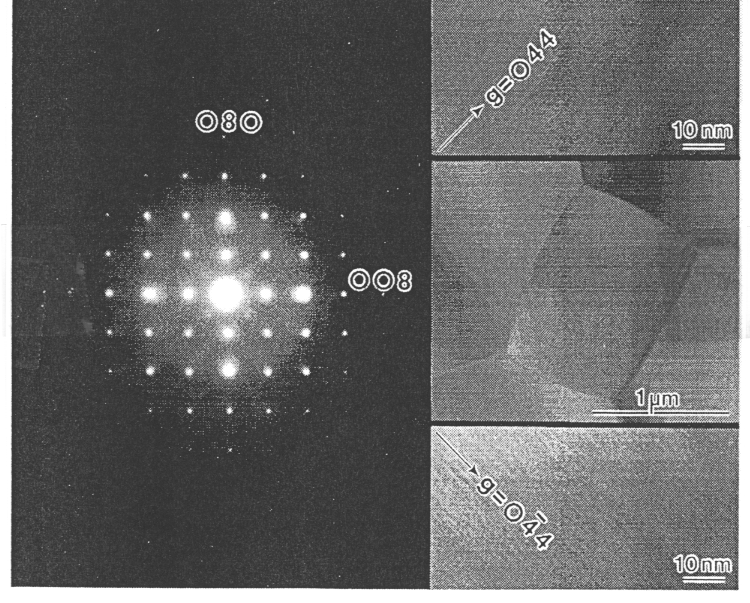

Majorite (Mg3MgVISiVISi3O12) bearing garnet solid solutions play an important role in petrologic models of the Earth's transition zone. The pure Mg-majorite endmember (Ma) synthesized and quenched from high pressure and temperature has, in contrast to most other known garnets, tetragonal symmetry. In this project we investigate whether majorite garnet is cubic at synthesis conditions and undergoes a phase transition to the tetragonal garnet structure during the quench. Because the stability field of MgSiO3 majorite (above 16 GPa, 1600 °C) is not easily accessible for in-situ measurements, we are trying to solve the problem by symmetry analysis of quenched garnets of the solid-solution series majorite-pyrope (Py, Mg3Al2Si3O12) with the compositional variable substituting for temperature. As reported previously, quenched majorite-pyrope mixed crystals are tetragonal for Py<20mol% and cubic for Py>20mol%.
This kind of phase transition is called ferroelastic and is well known
in material science, e.g. in the case of the high temperature superconductor
YBa2Cu3O7- .
During a ferroelastic phase transition a single crystal develops pseudo-merohedral
twins which change the smooth crystal surfaces of the high-symmetry phase
into stepped surfaces of the low-symmetry structure. However at extremely
high pressures and in a polycrystalline aggregate such a deformation of
mineral surfaces is unlikely. We are therefore also investigating the mechanism
of a ferroelastic phase transition under constrained conditions.
.
During a ferroelastic phase transition a single crystal develops pseudo-merohedral
twins which change the smooth crystal surfaces of the high-symmetry phase
into stepped surfaces of the low-symmetry structure. However at extremely
high pressures and in a polycrystalline aggregate such a deformation of
mineral surfaces is unlikely. We are therefore also investigating the mechanism
of a ferroelastic phase transition under constrained conditions.
Microstructural investigations of the majorite-pyrope garnets show needle-like
pseudo-merohedral twins and curved merohedral twins for Py < 15.6 mol%,
consistent with a phase transition m3m ->
4/m during the quench. At a composition very close to the phase
transition (Ma84.4Py15.6), we observe,
on the other hand, only very fine pseudo-merohedral twinning on a nanometer
scale but no curved merohedral twins (Fig. 3.4-3). This is taken as evidence
for point group 4/mmm and suggests a two step-mechanism for
the transformation of these garnets, corresponding to a sequence of space
groups I a![]() d ->
I 41/a c d ->
I 41/a.
d ->
I 41/a c d ->
I 41/a.
 |
Fig. 3.4-3: [100] zone of Ma84.4Py15.6 with very fine pseudo-merohedral twinning. |
In some grains of polycrystalline Ma84.4Py15.6 we observe the fine tweed only in the centers of grains but coarser pseudo-merohedral twins near the surfaces. Such a microtexture is to be expected for a ferroelastic phase transiton under constrained condition (A.E. Jacobs, Phys. Rev. B 52, 6327-6331, 1995).
In order to compare the microstructures of these majorite-bearing garnets to others that have a cubic to tetragonal phase transition at better known and easily accessible conditions, we have also synthesized and studied Ca3Mn3Ge3O12 garnet. This structure undergoes a transition from cubic to tetragonal symmetry due to the Jahn-Teller distortion of the Mn3+ crystal field at 230 °C and room pressure. TEM observations of these garnets show fine pseudo-merohedral twinning but no merohedral curved twins, i.e. the symmetry of this tetragonal garnet is higher than 4/m as proposed in the literature. From symmetry arguments the true symmetry change is m3m (cubic) to 4/mmm (tetragonal) and is thus proper ferroelastic, equivalent to the symmetry change observed for the Ma84.4Py15.6 majorite composition.

Tel: +49-(0) 921 55 3700 / 3766, Fax: +49-(0) 921 55 3769, E-mail: bayerisches.geoinstitut(at)uni-bayreuth.de
 Previous page
Previous page